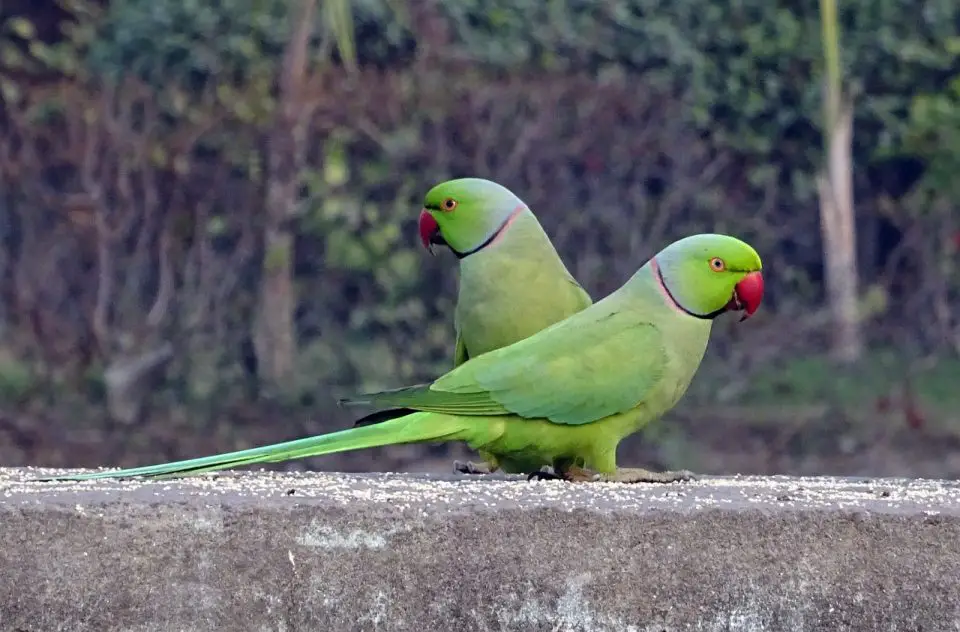Hi, my name’s Irena and I live on Crete in the beautiful Mediterranean Sea!
Today we’re going to explore the lifespan of Parakeets, or more specifically the question, how long do parakeets live?
To begin with, what exactly are parakeets? Well, they are small to medium-sized members of the parrot family.
They generally have long tail feathers and in fact, the word, parakeet, means long tail. Parrots are larger and have stockier bodies.
In the wild, parakeets live in flocks and are very social with each other. This extends to when they are in captivity so it is always better to get two parakeets as they will be company for each other.
In addition, they are capable of forming close bonds with their humans. They enjoy the attention they get from people and as a result, they are very popular as pets.
They are outgoing and are intelligent to the extent that they can even learn words.
Parakeets don’t take long to adapt to living in a cage, although it is a good idea to let them fly around the room they live in.
Just make sure that all windows and doors are shut. They like to have things to do so make sure that you put toys and climbing frames in their cage.
Try and get as big a cage as possible so that they have plenty of room. Who wants to be cramped day in day out? Birds are made to fly.
Are Parakeets and Budgerigars the Same?
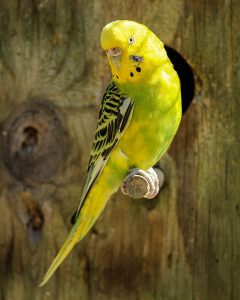 The truth is that all budgies are parakeets, but not all parakeets are budgies. The larger parakeets are really parrots.
The truth is that all budgies are parakeets, but not all parakeets are budgies. The larger parakeets are really parrots.
In the US budgies are called parakeets, but in the rest of the world, they are referred to as budgerigars.
However, despite some people saying that they aren’t the same, their taxonomy is identical and the scientific name for both budgies and parakeets is Melopsittacus Undulatus.
To make things even more complicated, there are parrots who are actually called parakeets; for example the Mustache Parakeet, the Grass Parakeet, the Monk Parakeet and the Indian Ringnecked Parakeet.
I hope you’re not confused by all of this. I know I was a bit when I started to do some research.
Whether you call them budgies or parakeets, it is interesting to note that they are the third most popular pet in the world, just below dogs and cats.
They have been popular as pets for a long time and they originated in Australia in the grasslands where it was found that they are hardy little birds.
They move together with their flock looking for water in the drought season and searching for suitable food like grains, grass, seeds and insects.
How Long do Parakeets Live?
You may be surprised to learn that there are around 120 species and sub-species of parakeets. I know I was.
Because of this, you can’t give a generalized lifespan. The different species can vary from 5 to 30 years of age.
Parakeets that are budgies tend to live shorter lives than parakeets which are parrots.
I found this quite surprising as it is the complete opposite to dogs. Smaller dogs generally live longer than larger dogs.
As an example, a budgie lives for between 5 and 10 years, a Plain Parakeet for around 15 years and a Monk Parakeet for 15 to 20 years.
The oldest parakeet raised in captivity was 30 years old. If you look at a large parrot such as the Macaw they can live for 35 – 50 years.
Surprisingly in the wild, some parakeets can live longer than captive parakeets even though they are exposed to the elements and predators.
For example, wild Indian Ringneck Parakeets can live between 20 – 30 years with the oldest documented being 50 years old. Caged Indian Ringnecks live between 15 – 25 years.
If you are looking for a pet that has a medium life expectancy, a parakeet is ideal.
Not everybody wants pets that can live for 50 years as the parakeets or parrots may outlive them and they might not have anyone to look after them which is something I worry about now that I’m getting older.
I’m sure that a lot of people feel the same.
Different Lifestages of Parakeets
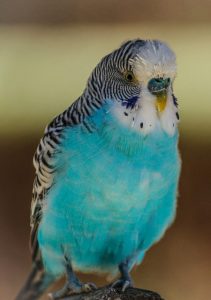 Parakeets reach adulthood at around 8 months of age. Before they reach that age, there are a number of ways by which you can determine their age if you don’t know it when you adopt your bird.
Parakeets reach adulthood at around 8 months of age. Before they reach that age, there are a number of ways by which you can determine their age if you don’t know it when you adopt your bird.
However, a good breeder should be able to tell you the age of the parakeet.
For a start, eggs need between 18 – 20 days to hatch. Then it takes another 8 weeks until the fledglings are fully weaned.
You need to make sure that they are fully weaned when you take them on as they still need their parents below this age for feeding purposes.
Now, let’s look at how to determine how old your parakeets are. If they have stripes all over their heads down to the base of their beaks they are definitely juveniles.
At around 4 months of age, they will molt for the first time and the stripes will be replaced by white feathers.
Another thing to look out for is the change in the color of their eyes. Baby parakeets have jet black eyes and if your parakeets have eyes this color you will know that they are less than 4 months old.
At 4 months their eyes change to dark grey with black pupils. The color stays the same until they are 8 months old when their eyes start to turn to light grey.
When they are this color you will know that your parakeet is reaching adulthood.
Another thing that determines their age is the cere. This is the strip at the bottom of the beak where the nostrils are. If your parakeets are less than a year old, the cere will be either grey or bluish.
Once they are a year old, the cere becomes darker. Males, as is often seen in the animal world, are brighter than females.
Their ceres change to vivid colors like violet, pink and blue. The ceres of females, on the other hand, are a little muted. They can be white, tan, brown or light blue.
How to Ensure That Parakeets are Healthy?
If you decide to adopt parakeets you will want to ensure that they stay healthy and that they live as long and as happy a life as possible.
To do this you will have to make sure that they have an ideal habitat and a suitable diet, as well as making sure that they have entertainment. They can’t just be left in a bare cage.
Habitat
The first thing you have to do even before you get your parakeets is buy their cage. If you are just adopting one parakeet, the cage needs to be at least 20″ x 18″ x 18′.
If you get more than one, it is advisable to get a cage of around 30″ x 18″ x 18″ if not more. The bigger the better.
The wires shouldn’t be more than 1/2 inch apart otherwise your parakeets could get their heads stuck. Parakeets are nosey birds and you don’t want them to get into any trouble.
Make sure that the cage has at least 3 perches as your parakeets will enjoy resting in different places. They can’t just sit down on the bottom of the cage.
Perches replicate the branches they would sit on the wild. They also enjoy different materials to perch on and will fly between them for variety.
When it comes to feeding dishes you will need two, one for moist food like fruit and vegetables and the other for dry food like pellets and seeds.
Stainless steel is the best when it comes to food dishes as it doesn’t hold onto odors.
In addition, you will need to install a water bottle which will keep the water clean and safe and will work much better than a water bowl. Feathers could fall into a water bowl for example.
You will need to put a lining on the bottom of the cage for waste matter. Shredded paper or even whole sheets of newspaper works the best.
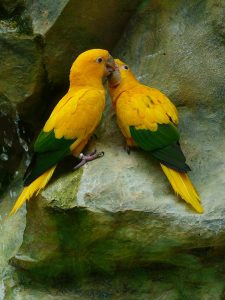 Don’t use pine or cedar shavings as they are toxic to parakeets as they are to rodents and other small animals.
Don’t use pine or cedar shavings as they are toxic to parakeets as they are to rodents and other small animals.
When it comes to cleaning, remove and change the paper at the bottom of the cage every day and also after your parakeets have had a bath.
Each day you will also need to wash out their food bowls and water bottle. Stainless steel bowls can be boiled once a week to sanitize them.in.
In addition, wipe down the surfaces of the cage with a bird-safe disinfectant or white vinegar mixed with water each week.
It is also essential to clean the perches and any toys your parakeets might have. Bacteria can collect anywhere and you don’t want your parakeets picking up any infections.
Parakeets need to bathe, so every couple of days provide them with a shallow water container of lukewarm water.
Keep an eye on them while they are bathing to make sure they don’t get into any danger.
If they’re not interested in the bath, you can try washing them with a spray bottle. Always let them air dry as they could be traumatized by a hair drier.
Diet
The largest part of the diet for your parakeets should be pellets specially formulated for birds. They contain the right micro and macronutrients that your parakeets need.
Seeds are fattening, but they are also good for your birds so give them just a teaspoon each day.
10 -15% of their diet should be made up of fruit and vegetables, with an emphasis on vegetables. Parakeets like melon, grapes, oranges, kiwi, apples, pears, spinach, parsley and cabbage.
Other good additions to the diet include a cuttlebone and a mineral block.
parakeets will peck at the cuttlebone and it will provide them with essential minerals. The mineral block does the same and in particular, gives them calcium.
Entertainment
Parakeets are very clever and like to be active so you should provide them with toys. You can get all sorts of toys like chew toys, puzzle toys and foraging toys.
Don’t buy toys with string as they could get caught up in the string. A mirror isn’t a good choice as they might decide that like their reflection better than their humans. Yes, this can happen.
How to Tell if Your Parakeets are Healthy?
There are lots of things you can look for to decide if your parakeets are healthy and hopefully will be able to live a long and happy life.
The first thing to watch is how they are eating. They should have a healthy appetite, especially in the morning. If they’re not eating well a trip to the vet is called for.
The next thing to do is to check the feet of your parakeets. Their feet are very sensitive and like rodents they can get infections on their feet.
Their claws shouldn’t be so long so that they can’t grip their perches. If you don’t feel comfortable trimming their claws yourself, you can always take your birds to the vet.
Parakeets, like most birds and animals, will groom themselves. If you don’t notice them doing this and they start to look scruffy, you may have to pay a visit to the vet as there could be an underlying cause.
Parakeets are usually the most active during the day and sleep at night. If they are lethargic during the day, this could indicate some sort of illness.
In addition you need to look out for respiratory problems. If they breathe with their beaks open this could be a sign of breathing problems.
The cere should be waxy, without any crusts and their dropping should be firm.
Final Thoughts
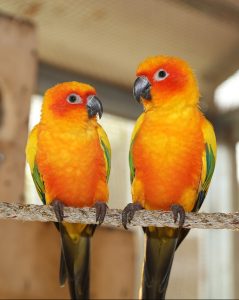 I hope that you have enjoyed reading my article about parakeets. As you will have seen, there is quite an age range in the length that they can live, from 5 years up to even as long as 30 years.
I hope that you have enjoyed reading my article about parakeets. As you will have seen, there is quite an age range in the length that they can live, from 5 years up to even as long as 30 years.
They become adults at around 8 months of age and it is interesting to watch them change as they grow up.
Like any other pet, they are a commitment and you need to decide if you will have the time to devote to their well-being. If so, you will have a wonderful and intelligent addition to the family.
